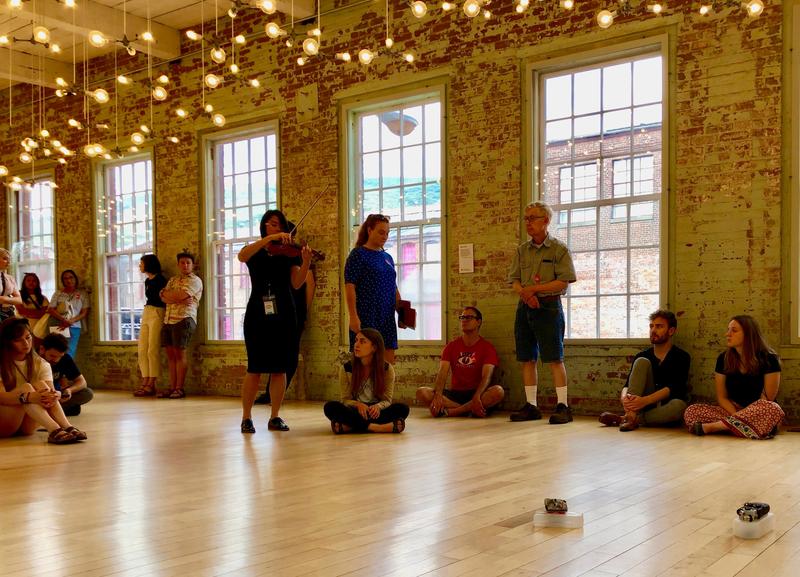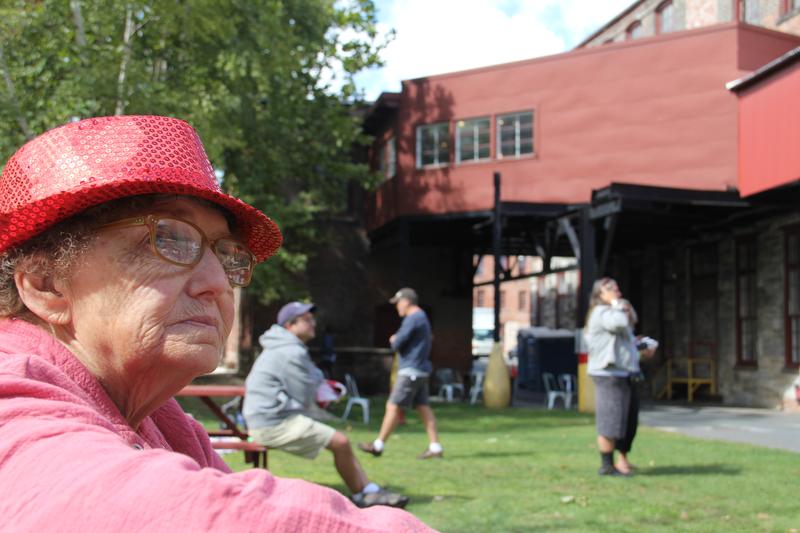
Today is the beginning of the end. The Bang On A Can Summer Festival wraps up with the first “LOUD Weekend” - 3 days and nights packed with live music. Our Media Fellows have been preparing all week, shadowing the Composition and Music Fellows as they rehearse, and following their daily recitals in and among the art works here at MASS MoCA. It’s been busy but manageable so far. Here are some of their final thoughts about this week before all hell breaks loose this weekend. - John Schaefer
Visual counterpoint: The newest music at MASS MoCA
By Jeremy Reynolds
There’s always that one guy wandering around galleries or art museums wearing headphones, lost in his own little world and inhabiting that sweet focal point between the two mediums. But this is an isolationist practice. At MASS MoCA for three weeks each summer, music and visual art fuse together in an all-enveloping community experience. Visitors see the same works of art and, during any of the plethora of concerts staged by participants in the Bang on a Can Summer Festival, hear the same music, as unsuspecting passersby get sucked into the orbit of whatever irresistible bang-squonk noises are emanating from just around the corner.
Daily lunchtime recitals feature music by contemporary composers, setting up a counterpoint to the paintings and sculptures and installations that inhabit the museum. Brand new works by young composers pepper these and other concerts specifically dedicated to music they’ve written since arriving at the Festival.
On Wednesday, all eight of the Festival’s young composers had brief miniatures premiered by fellow and faculty musicians in one of the museum’s larger performance spaces. Each piece lasted only two or three minutes, and the composers were constrained to writing for only a couple or a few players at most. Dai Wei’s music for vocalising soprano (Theodosia Roussos) and cello (Nick Photinos) was particularly arresting, as the two musicians intertwined melodic fragments that began with moxie before trailing away and winding down to a gentle, contemplative close. Dutch composer Celia Swart’s piece for piano, guitar, bass clarinet and percussion was also poignant, centered around an anxious bit of a tune and chugging inexorably forward with ever-shifting rhythmic grooves.
A pair of politically charged spoken-word pieces closed the recital: Phong Tran reeled off his own angst-laden, rapid-fire text that read as a stream of consciousness about repetition and echo chambers, punctuated by scathing stings; and composer Darian Thomas read a thunderous, personal account of his response to the 2016 presidential election and its bitter ensuing conflicts, with three musicians verbally echoing and abetting his words, whispering softly behind Thomas in supportive condemnation. This work moved from a taut murmur to a roaring shout, a raw, passionately vulnerable experience.
Several of the composers had their works premiered at the lunchtime concerts throughout the week. During Tuesday’s performance, a quartet of violins brought another of Thomas’ pieces into the world. “Untitled” began with ethereal shimmering in the upper register of the instruments, with each player ritualistically walking from the corners of the room to the center and back again. Tones shifted from quiet, chordal chirps to yawning glissandos, before gaining in dynamic energy, like electrons excited by absorbing the light. Artist Spencer Finch’s Cosmic Latte installation, a series of celestial LEDs emitting light at the average color of the universe, hovered above the listeners. While the piece dragged a touch in its conclusion, the interplay between the music and visual art here proved enchanting, even serene.
Two additional pieces by Swart received strong lunchtime debuts. The first seemed contemplative, a reverberant affair for amplified piano, violin, cello, guitar and percussion. Before the performance Swart, who grew up in a small town, explained that the piece was inspired by the sensation she felt on first witnessing the Hague skyscrapers. This suggestion helped the piece take on a detached air of wonderment, a strong sense of internal rhythm guiding the music to a graceful close. Internal motion seems a key component of Swart’s pieces, as her final work surged out in a flurry of high-pitched guitar and piano and violin pitches, swelling and thickening to a final, crystalline vibraphone chord that tolled with a sense of deep finality.
An Oberlin-trained clarinetist, Jeremy Reynolds is the classical music critic and reporter at the Pittsburgh Post-Gazette. He also writes for Symphony Magazine, Early Music America magazine and San Francisco Classical Voice among other publications and has worked as an announcer at WRR Classic FM in Dallas and WCNY in Syracuse, NY.
Rose Marie and the Bangs
By Hannah Edgar
Annea Lockwood’s Thousand Year Dreaming can be baffling, and even more so when it’s being played in a place like MASS MoCA. The sound of gongs, blown conch shells, and multiple didgeridoos thunder throughout the halls. Most patrons only stick their heads in the rehearsal space briefly before moving on to the rest of the galleries, heads shaking incredulously.
But one woman sits front and center—a doll on her lap, red bedazzled fedora on her head. After the final note, she hoots and applauds thunderously.
What drew her in, you ask? “I love the didgeridoo,” she says with a shrug.
That may be so, but it’s not quite the whole truth. Rose Marie Thomas, 80, has been a bona fide Bang on a Can groupie since the festival’s 2002 inception at MASS MoCA. She’s also spent her entire life here, in this complex of buildings. The lifelong North Adams resident worked at the Sprague Electric Company factory, which produced conductors and other electrical components. She joined the Sprague assembly line in the late 1950s as a high school graduate.
“I soldered, I assembled, I wax-poured, I riveted — I did all kinds of things,” Thomas says.
Sprague left in 1985, shuttering the factory after declining sales. But Thomas stuck around. When it was announced that the campus would be transformed into a large-scale contemporary art museum, she and a group of volunteers helped clean the buildings and stuff envelopes. Once MASS MoCA opened in 1999, she became an usher.
Her ubiquity at the museum means she’s befriended more than a few of “The Bangs”—as she calls the festival’s musicians and staff—along the way.
“You notice that someone’s there for every recital, and she’s kind of striking-looking,” says former Fellow and pianist Karl Larson. “Every summer I came back, I got to know her a little better. Now we’re on a first-name basis.”
During the festival’s inaugural season, faculty violinist Todd Reynolds also found Thomas impossible to ignore, but for a different reason: She would talk back to the performers.
“Rose was so unfiltered that you’d be doing a spiel with the audience, trying to tell them about a piece, and she’d agree with you verbally,” he remembers. “In a normal classical context, you wouldn’t expect that. But very quickly I came to understand it’s not something to be avoided, but embraced. We play weird, loud music, and she’s enjoying it enough to come back every single time.”
Many know Thomas as gregarious now, but she claims that wasn’t always the case. She remembers a time when women were only expected to leave the house with their husbands—something that never much suited Thomas, a self-professed “loner.”
“My mother always said, ‘A woman doesn’t go anywhere alone; she has to go with her husband!’ But if I waited for my husband to go out, we’d never go out,” she says.
Her husband Norman, who died in 2014, never accompanied her to MASS MoCA. After the plant closed, he had difficulty holding down steady work for the rest of his life.
“He worked in a lot of places. That’s how alcoholics are,” she says. “They always had money for a drink.”
Before Norman passed away, Thomas joined Al-Anon. She credits it with changing her life.
“Now I’m a public speaker. I’ve been in plays here,” she says, referring to MASS MoCA’s participatory 2002 play The Dream Life of Bricks. “Before that? No way. It’s all thanks to Al-Anon.”
Neighbor and friend Cheryl Tarczynski can hardly imagine a time when Thomas wasn’t a woman about town. After moving to North Adams several years ago, she explored the Bang on a Can summer festival on her own. Almost by accident, the two women began attending gallery recitals together. Eventually, Thomas began saving a seat for her near the front.
“A long time ago, I would have that rigid thinking: You don’t go someplace without a friend, or a date, or a husband. And she’s decided, ‘If I like something, I’m going to do it, and I don’t care if nobody is with me!’” Tarczynski says. “It’s opened up the world to me. It made me realize I’ve watched too many football games and not done the things I want to do.”
Though Thomas and Tarczynski attend MASS MoCA events religiously, they acknowledge that they’re part of a small minority in North Adams, where many longtime residents are skeptical of the museum. Tensions sometimes boil over in public clashes between the town and institution, as it did in 2017, when the museum painted over a public art project under the Route 2 overpass.
“It’s sad, but most people are not as flexible as [Rose Marie],” Tarczynski says. “Most people want Sprague to stay open.”
Nonetheless, Thomas remains an avowed proselytizer for MASS MoCA. Her story isn’t uncommon: The museum’s earliest boosters included many older women who had retired or been laid off from Sprague. One of them, Ruth Yarter, is centrally featured in Museum Town, a new documentary about MASS MoCA and its relationship with North Adams. (Yarter passed away last year.)
“They had a strong emotional investment in North Adams, and for whatever reason didn’t see the building changing into this haughty cultural building as a negative. They were like, ‘This is cool,’” Larson says.
Even among MASS MoCA’s supporters, however, Thomas occupies a special place. For the museum’s 20th anniversary Block Party in May, founding director Joe Thompson suggested that all the ushers wear sequined red hats outfitted with LEDs in tribute. Since then, Thomas has traded out her old hat—a souvenir from Disneyland—for the honorary light-up hat.
Bang on a Can has also found its own way to honor Thomas. During an afternoon recital celebrating the summer festival’s 15th anniversary back in 2016, Reynolds presented Thomas with a gift: a small, plush lookalike sewed by Phyllis Criddle, MASS MoCA’s director of retail operations. The doll sports a Bang on a Can t-shirt and, of course, a red hat.
“I call her my mini-me,” Thomas says.
Hannah Edgar is a Chicago-based editor, writer, and researcher. Recent bylines include Chicago magazine, The Classical Review, WFMT, and New York Philharmonic program books (2017/18 season).






